Cats are territorial species born with sharp teeth and talons designed to hunt, catch prey and protect their domain. When a cat is fearful, defensive, aroused, or stressed, it can transform from a loving pussycat to a ‘panther’ in a matter of seconds biting and clawing their way out of a situation.
Training a cat to not bite is challenging, requires knowledge of normal feline body language, correct identification for the biting behaviour together with plenty of patience and perseverance. Don’t expect immediate results.
Why Cats Bite?
Although cats are affectionate and sentient, they’re emotionally motivated by positive and negative feelings. Each cat responds differently to events or stimuli, always on the guard prepared to defend their territory from predators and whoever they perceive threatening.
Let’s evaluate the most recurrent reasons why cats bite!
Fear, Anxiety, and Stress
Most common biting and aggression is because of activation of the fear-anxiety emotional system.
The fear-anxiety system is triggered when a cat perceives a threat to individual or resource safety. When the stimulation is intense, cats tend to escape or evade the situation, with weaker stimulation, cats tend to display freezing behavioural reactions (remain incredibly quiet and infrequently vocalise). If they’re unable to avoid or inhibit the fear/anxiety, a cat may demonstrate the fight response by shifting to a defensive attack.
The defensive response manifests initially as a warning through hissing, growling, and spitting, then will escalate to scratching and biting. The severity depends on the individual, it’s previous experiences during the socialisation period (2-7 weeks of age) and/or negative handling experience.
Certain cats learn that acting aggressively works well when attempts to flee or hide were unsuccessful. Once this behaviour is reinforced by people pulling away or withdrawing their hand, the cat learns that this can be an efficient strategy and will resort to this approach rapidly when it predicts threatening situations or events.
Lastly, when the fear-anxiety system is set in motion a cat is usually hyper-vigilant, scanning constantly the environment for stressors therefore the slightest sound or touch can startle them.
Pain and Disease
Animal pain is a distressing sensory encounter correlated with soft tissue damage or emotional occurrence.
Pain, discomfort, trauma, and disease alter a cat’s mood negatively, decreases the necessity for physical contact additionally reduces overall tolerance threshold similarly increases aggression and potential for biting.
Frustration
Frustration is caused by a cat’s failure to obtain resources, maintain control of them or the situation, defend its possessions and territory. Most frustration cases occur when a cat can’t get immediate access to food, owner attention, access outdoors, is locked within a specific part of the house or caged at a vet clinic.
A cat will solicit attention by excessive loud meowing, pawing, extreme rubbing, pacing, and destructive behaviour. If he/she doesn’t obtain what they want or the worth of the reward is less than expected, the frustration system will intensify with a greater level of arousal subsequently behavioural responses will precipitate the moggie resorting to hissing, biting, and scraping.
Expression of frustration through redirected aggression towards the owner or nearby pet in a form of swiping and biting is widespread, typically elicited by the presence of another cat viewed from a window unable to defend its territory.
Misdirected Predatory Behaviour
Biting is an instinctive behaviour that is part of play and predation.
A cat that’s prevented from hunting prey or play with appropriate toys, may exhibit predatory behaviour toward sprinting objects like an owner’s limbs and hands. The cat’s arousal and actions intensify when a cat parent abruptly moves and screams causing the bite pressure reflex to increase resulting in unintentional serious punctures.
Petting Induced
A cat may implore the owner’s attention, then will stop the interaction with biting or clawing because of overstimulation from being touched in vulnerable body parts or for a long duration.
How To Teach Your Cat Not To Bite or Scratch?
Set Up for Successful Cat Training!
Like most cat training, it’s easiest to train a cat not to bite when they’re still young. Establishing good habits at an early age is vital.
Successful training should start when your cat is calm, quiet in a familiar setting since fearful cats are extremely sensitive and will flee from any noise, threat, or insecurity.
Your cat’s personality and mood should be taken into consideration since nervous kitties tend to find new objects and experiences intimidating.
The chosen area must be free of distractions (i.e. humans, kids, pets, food, smells), contain a water bowl, litter tray, and a retrieval spot (i.e. box, tunnel, cat tree) to hide or relax after they had enough.
The training method, rewards (i.e. food, toys), props (clicker, target stick) length of the session (about 3-5 minutes) should be tailored to your cat. Food reinforcements should be tiny of high value with sessions in between mealtimes when your cat is hungry.
Toys must be wand or rod-type toys with feathers since they can be swept fast along the ground, imitate prey movement, and, perhaps most importantly, provide distance from your hands and feet. This reduces the chance of being bitten since the cat can claw and bite into the attachment instead of you!
Furthermore, it’s essential to consider previous adverse experiences specifically if you’re trying to alter your cat’s emotional state to a positive one since such training takes an extended time requiring a slow pace.
Lastly, dress in thick pants, long sleeve clothes plus closed-toe shoes to minimise injury from potential clawing or biting.
Treatment & Training Methods
It’s imperative to investigate the underlying cause of the biting or trigger to set your cat for success before attempting any of the techniques described below.
Method 1: Behaviour Modification – Desensitization and Counterconditioning (DS/CC)
Use behaviour modification techniques of desensitization: a process by which diminishes emotional reactions to aversive or negative stimulus after frequent exposure to it and counterconditioning to assist your cat to associate the scary stimulus with a positive experience.
Here’s a demonstration by Dr. Sally Foote of counter-conditioning a cat to petting and handling by pairing it with food. The petting is associated with things the cat enjoys in brief bouts being mindful of sensitive areas on the cat’s body while observing for escalating excitement.
If your cat is fearful and lashes out at strangers, use DS/CC by pairing their favourite treat with seeing the stranger first from a distance then gradually decreasing the distance by repeatedly feeding their favourite food once they are relaxed within the presence of that person.
The stimulus will have to be repeated over many sessions until your cat changes their perception of the stranger to a positive one.
Please consult your veterinarian or a cat behaviourist if you’re having difficulties implementing DS/CC.
Method 2: Clicker Training
Clicker training is principally used to teach new behaviour by employing a clicker sound immediately as your cat performs the specified behaviour and rewarding it.
For instance, if your cat bites to grab your attention, teach them to ‘ask politely’ by training cues like ‘shake’ or ‘high-five’. As long as you remain consistent and only reinforce positive behavior, your cat will learn that touch works, but biting doesn’t.
Ultimately, you want to teach your cat healthy ways of interacting with you.
Method 3: Target Training
Like clicker training, target training gives the cat an appropriate behavior to try and do rather than the problem behaviour by using a target stick the animal touches, then you mark the behaviour by clicking and providing a reward for the positive reinforcement rather than swatting and biting.
Learn how Kate Luse solved Abbie’s fear aggression applying a target stick.
Method 4: Teach Correct Play With Appropriate Toys
To address misdirected predatory behaviour; introduce kittens moreover redirect adult cats onto inanimate objects (known as object play) rather than tantalize them by wriggling fingers or toes.
Object play refers to items like ping pong balls, jingle toys, wine corks, scrunched paper ball, pasta shells, that are batted, chased, pounced and grabbed with teeth and/or nails. Keep few in your pocket and toss them away just before your kitty decides to nip on you, distracting them providing you with sufficient time to move away.
Don’t deny your cat this play opportunity since it expresses natural predatory behaviour whilst decreases the necessity to chase and attack your limbs.
Appropriate play should similarly include a long wand type rod where an individual uses a pole with fast sweeping action, enticing the cat to chase the feather, string or soft object on the top of the stick which keeps hands and feet out of reach.
Avoid this common mistake of luring your cat to play with a tiny toy in your hand since your cat may regard your hand as a part of the toy, attacking it after you stopped playing.
Lastly boost frequency of play, introduce puzzle feeders and outdoors exploration.
Method 5: Reinforce Positive and Calm Behaviour
Inadvertently pet parents reinforce attention seeking behaviour by giving a cat something it values (treat, petting, attention), instead you should only reinforce positive behaviour.
Initially the behaviour will get worser before it becomes better, however if you remain consistent, you should notice improvements within few days of ignorance, this is often referred to as extinction burst.
Training a cat to remain calm can help minimise redirected aggression, reduce stress and build confidence. To alter a negative behaviour, reward the behaviour you want like sitting quietly or teach ‘Go to mat’ cue utilising a towel, mat or any flat item that may be carried around.
Training ‘Go to Mat’ encompasses reinforcing and rewarding your cat to return to her ‘calm’ place with the objective of encouraging this cue to stop confrontation with other pets and keeping them relaxed.
Method 6: Cat Owner Education
This method resolves petting induced biting since it operates on changing your behaviour rather than the cat’s.
Learn to read your feline’s body language. Concentrate on where your individual cat likes being petted (usually on top of the head and chin, sometimes on the back) and limit patting to these areas.
Next, assess how long they like being stroked similarly if they like slow or fast caressing or something in between, lastly cease contact before he/she displays signs of agitation (stops purring, dilated pupils, swishing tail, stiff body, even hissing). Ideally, stop petting after couple of minutes to avoid overstimulation.
Importantly, avoid picking your cat up unless they enjoy it!
Tips and Tricks
It may sound contradictory and can take a while to put into practice, don’t pull your hand or foot away when your cat bites you, it’s to make sure you don’t mimic prey trying to escape which may trigger your feline to pursue and gnaw even harder. Instead, baffle your cat by pushing or tapping them gently on their shoulder which will cause the release of your body part.
Drain your cat’s energy by taking it for long walks ensuring it has lots of daily exercise. Agility training particularly for indoor cats could be a wonderful way to work out, release panted energy whilst help with aggressive tendencies. Generally, frustrated ‘aggressive’ moggies should have unrestricted outdoor access with plenty of climbing together with exploration opportunities.
Never shout or punish your kitty particularly when it’s in a very highly provoked state.
Always work with the individual cat in front of you and alter the approach or method to fit your special kitty.
Conclusion
Successful training outcomes are based on the identification of the precise reason for the biting behaviour and the technique suited to your individual cat.
In some cases, medication or supplements is also needed additionally to behaviour modification.
Also Read: The 10 Best Cat Slow Feeders & Puzzle Feeders
Frequently Asked Questions
How do you train a cat not to bite you?
Training a cat to not bite should begin in kittenhood by teaching it appropriate play with inanimate objects rather than dangling hands/feet.
For adult’s behaviour modification with the help of clicker in addition to target training together with teaching a relaxed or new behaviour may resolve gnawing.
Why do cats bite their owners for no reason?
Cats don’t bite without a reason. Cats are both predators and prey hardwired to fight or flight consequently get easily stimulated and if there’s no means of escape because of perceived danger will forewarn you before biting.
Learn to recognise the warning signs of aggression before an imminent attack which may be stopped or redirected with the help of wand-type toys before the provocation.
What to do if your cat is biting you?
As hard and painful as it may sound, remain calm, don’t move or make any noise to reduce reinforcing the behaviour, just push your cat’s body gently till it releases your body part.
Once your cat let goes of the hand or foot, stop interacting with them and leave the area immediately to attend to any wounds.
What does it mean if your cat bites you?
Playful nibbling is a sign of affection, misdirected nipping means your cat is under stimulated while deep biting is usually caused because of fear, anxiety and distress.
-
Stanslaski, J. (2020). Why does my cat - Curious and odd behaviours of our feline companions. International Society of Feline Medicine Symposium (pp. 9-13). ISFM. Retrieved July 16, 2021
-
Helen Tuzio, T. E. (2004). FELINE BEHAVIOR GUIDELINES. (A. A. Practitioners, Compiler) USA: AAFP. Retrieved July 21, 2021
-
Miller, P. G. (2021, July 17). Training Cats. Barks from the Guild. (B. Magazine, Compiler) USA.
-
Academy, K. P. (2016). Why Train a Cat. USA. Retrieved July 15, 2021
-
Care, I. C. (2021, July 19). What do I feel and am I ok? Emotions and their role in welfare assessment. Advanced Feline Behaviuor for Vet Professionals. United Kingdom: International Cat Care. Retrieved July 20, 2021
-
Ellis, D. S. (2021, January 01). Behaviour and body language associated with frustration Lecture. International Cat Care. Retrieved July 21, 2021
-
Luse, K. (2021, May). How Do You Solve a Problem Like Abbie? Using Target Training to Resolve Fear Aggression in an Unsocialized cat. The IAABC Journal. Retrieved July 26, 2021, from https://iaabcjournal.org/how-do-you-solve-a-problem-like-abbie-using-target-training-to-resolve-fear-aggression-in-an-unsocialized-cat/
-
Pryor, K. (2020, September). Train Your Cat. Waltham, Massachusetts, USA: Karen Pryor Academy. Retrieved July 26, 2021
-
Wikivet. (2015, July 16). Misdirected Feline Predatory Behaviour Towards People. Retrieved July 22, 2021, from https://en.wikivet.net/Misdirected_Feline_Predatory_Behaviour_Towards_People#Treatment
-
Zulch, D. S. (2010). Cat Behaviour Described Play. Retrieved July 11, 2021, from Cat Behaviour Described: http://www.learnaboutcats.co.uk/chapters/3-feline-play/Play.html
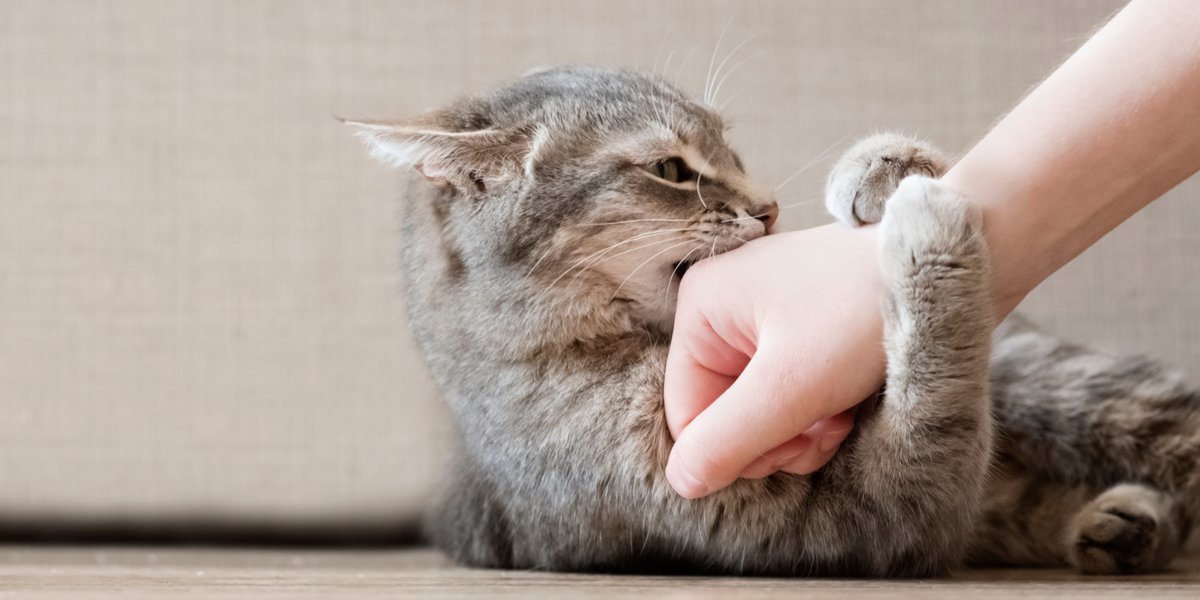
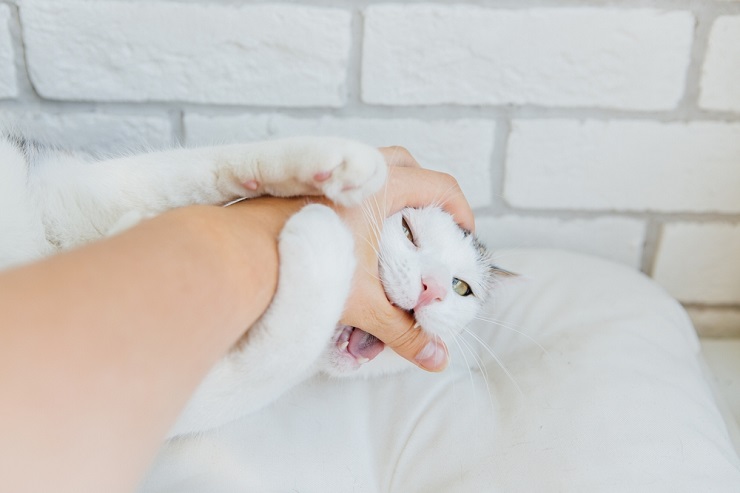
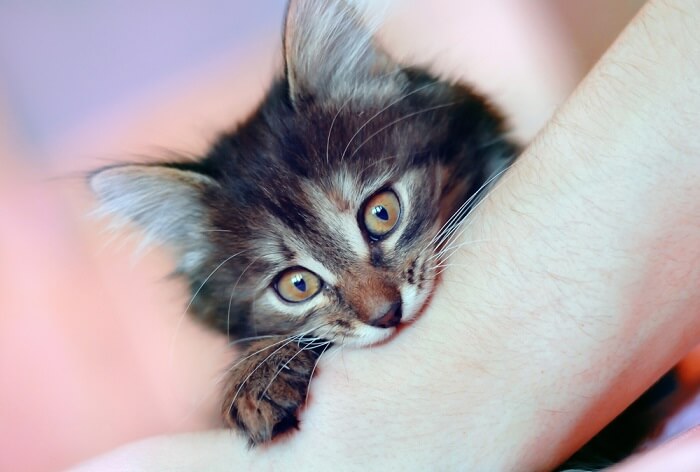
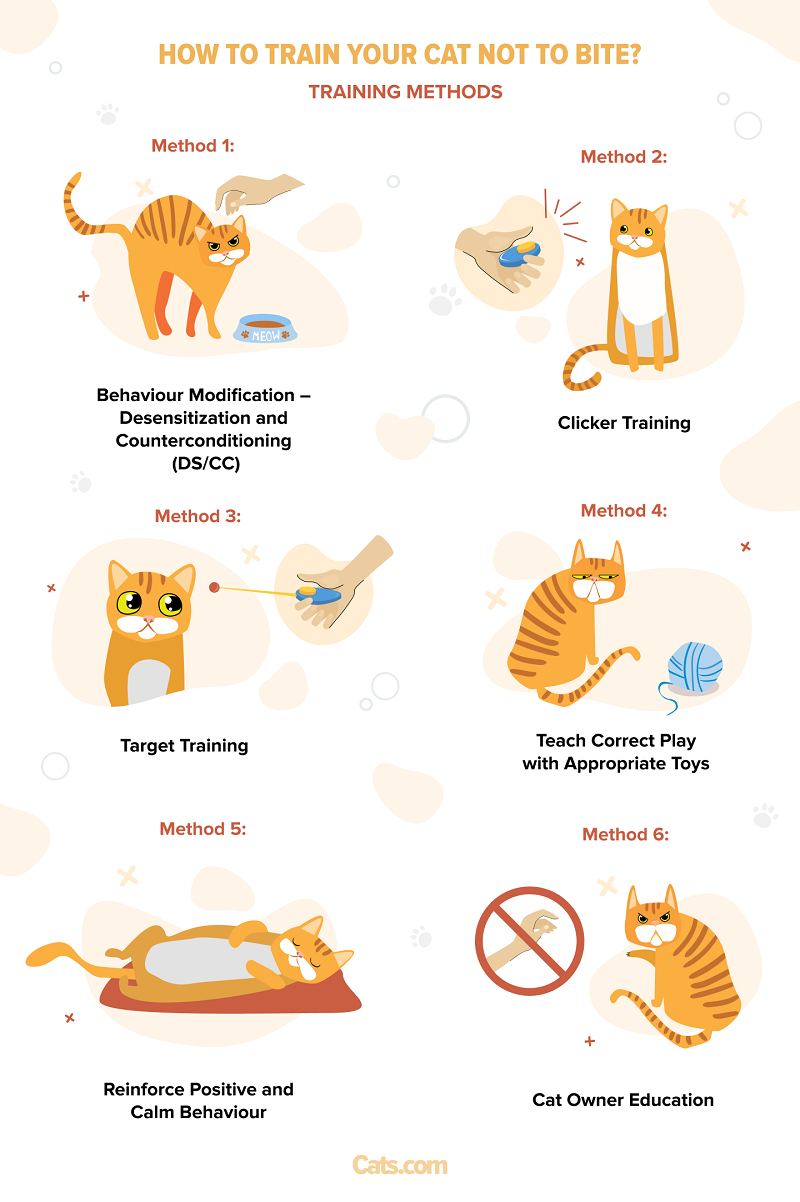
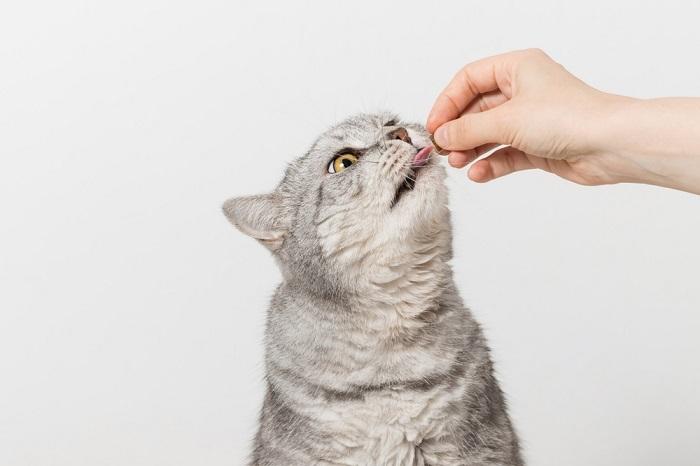
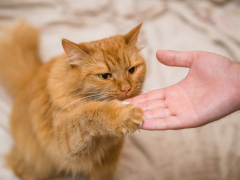
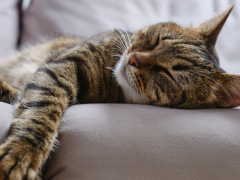



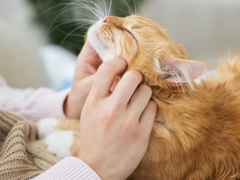

I have 2 (1 year+ old ) Birmans… one of them has decided he likes water and continually, despite all our efforts to come up with solutions, to play with and empty the water dish on the floor. It’s like a game to him. We’ve tried the metal bowls in a stand,, heavier bowls, non-skid bowls, even a small heavy travel bowl with a small hole in the top …. He manages to find a way to push them around until they are empty… which isn’t good for our second cat, who prefers to drink the water, not play in it!
Any suggestions to deter him from playing and dumping the water would be greatly appreciated!
Frustrated Cat Lover
Hi Diane,
Great question!
I would start by figuring out the reason for the behavior. Is he playing in the water due to boredom, anxiety, perhaps he doesn’t like his current water bowl (is it too deep or narrow, in close proximity to his litter tray or food bowl, etc), there could be several reasons.
Try purchasing few types of sturdy ceramic or stainless steel water-fountains with as little spillage risk as possible instead of the usual bowls, here are some options: https://cats.com/best-cat-water-fountain, https://www.petcircle.com.au/search?searchTerm=ceramic%20water%20fountain, https://www.petcircle.com.au/product/drinkwell-pet-fountain-360/d360ss-au-17?gclid=EAIaIQobChMI8KSv5NOo9QIVMplmAh2PewduEAQYASABEgIgKPD_BwE&gclsrc=aw.ds, https://www.amazon.com.au/Petkit-Eversweet-Water-Drinking-Fountain/dp/B08FXKQ8HX/ref=asc_df_B08FXKQ8HX/?tag=googleshopdsk-22&linkCode=df0&hvadid=466462883905&hvpos=&hvnetw=g&hvrand=12815962006163754951&hvpone=&hvptwo=&hvqmt=&hvdev=c&hvdvcmdl=&hvlocint=&hvlocphy=9071830&hvtargid=pla-1046746291382&psc=1
Meanwhile till you figure out the reason and purchase a drinking station, redirect his energy to another type substrate and increase exercise plus play therapy.
Hope this helps
Melina
I have a year old (we think) adopted Gold Point ? Siamese. She’s been with us 4 months. We have a 8 yr old female Manx as well. Both are slowly being assimilated. The Siamese loves to chase and fetch. She’s very active kitty and I’m still learning about her. Seems to have had some prior negative experiences as she often drops her head and backs away a little, when I bend down to pet her. Doesn’t tolerate a lot of affection yet comes looking for it. She will come to my chair and get up on the arm and often bite me. She’ll bite my leg if I’m in the kitchen doing something. Both of which suggest she wants attention or wants something ? I’m not sure. I’m reading how to curtail this biting and I know I have to learn more about this. I have an anxiety disorder and I’m thinking she might be picking up on this. So I’m trying not to react even when she clamps down but I find it very difficult. Do you think her anxiety is being set off or made worse by mine? And how can I better deal with the situational incidents. Recognising when she’s about to, isn’t always practical as my attention is directed to a task I am doing. Any advice would be gratefully appreciated.
Hi Debra,
Congratulations on your recent adoption.
Unfortunately, we don’t know much about her previous experiences so it will take her a little time to build trust with you. Most likely she wants attention or perhaps she bites sometimes due to frustration, maybe a previous caregiver reinforced the biting, so she continuously behaves that way. Since she is incredibly young and highly active, I would recommend keeping some jingling toys in your pocket, ready to be tossed away from your body when the need arises.
Cats are extremely sensitive and can feel our emotions nevertheless look after your well-being to ensure you can look after both cats. Learning as much as possible about cat body language, behavior and stressors in cats would also be beneficial.
Lastly, you can teach her a stationing cue like ‘sit on a stool’ using clicker training, which will keep her away from your legs while you reward her for positive behavior. I’ll email you the instructions later today.
Hope this helps
Melina
I adopted a 4 year old cat almost 2 months ago and she occasionally “love” bites me, but what I’ve read in your blog doesn’t describe my situation. She sits or lies next to me and rubs all over my thigh by moving around back and forth, and head butting my hand for me to pet her head, then she goes back to the rubbing. This can go on for quite awhile and during much of this time I stay still and just let her do her thing because I don’t want to overstimulate her. There’s no tail, wagging, stiff back, and when I can see them, no dilated eyes, and ears are in a normal position. The all of a sudden, she nips me. I am always surprised when this happens as there doesn’t seem to be any clues that she’s going to do this. From reading your article, it seems like she’s overstimulating herself. Why? Could it be from lack of attention from past living experiences? Please let me know what you think and how to stop this behavior.
Hi Linn,
Congratulations on your recent adoption.
It’s challenging to pinpoint the exact reason for the nipping unless you know her entire living history.
Perhaps she is trying to solicit your attention, convey her frustration or display misdirected predatory behavior.
There are lots of helpful tips and suggestions on how to stop the behavior at https://cats.com/cat-love-bites and https://cats.com/why-does-my-cat-bite-me
I hope it helps.
Melina
Read those articles already and others, more than once, no help. Her situation doesn’t seem to fit those parameters. That’s why I wrote you to possibly get more insight.